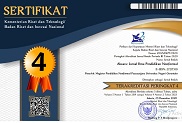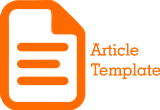Optimalisasi Sarana Prasarana Water Park Tiara Kota Gorontalo
Abstract
Keywords
Full Text:
PDFReferences
Anonim, 2009. U.U. RI NO. 10 Tahun 2009 Tentang Kepariwisataan.
Depdikbud. 1995. Kamus Besar Bahasa Indonesia. Jakarta : Balai Pustaka
Fandeli, Chafid. 1995. Dasar-Dasar Manajemen Kepariwisataan Alam. Yogyakarta : Penerbit Liberty
Hoetomo. 2005. Kamus Lengkap Bahasa Indonesia. Jakarta: Mitra Pelajar.
K. Yin, Robert. 2002. Studi Kasus (Desain dan Metode). Jakarta. PT. Raja GrafindoPersada.
Karyono, Hari. 1997. Kepariwisataan. Jakarta: Grasindo
Moleong Lexy J. 2000, Metodologi Penelitian Kualitatif, Bandung: Remaja Rosda karya
Pendit, 2002. Perencanaan Kepariwisataan Alam. Yogyakarta: fakultas Kehutanan Universitas Gajahmada
Pitana, I Gede. 2002. ìKebijakan dan Strategi Pemerintah Daerah Bali dalam Pembangunan Pariwisata. Pada Seminar Nasional Pariwisata Bali the Last or the Lost Paradiseî. Pembangunan Pariwisata yang Berkelanjutan. Denpasar: Universitas Udayana.
Puja Astawa I.B.G. 2002. Pola Pengembangan Pariwisata Terpadu Bertumpu Pada Model Pemberdayaan Masyarakat di Wilayah Bali Tengah. Denpasar: UNUD
Sharpe, William E. and Swistock, Bryan., 2008, Household Water Conservation, College of Agricultural Sciences, Agricultural Research and Cooperative Extension College of Agricultural Sciences, The Pennsylvania State University.
Soekadijo,R.G., 2000, Anatomi Pariwisata, Jakarta Gremedia Pustaka Utama
Sugiyono. 2007. Metode Penelitian Kuantitatif Kualitatif dan R&D. Bandung: Alfabeta
Sutrisno, 1998. Psikologi Pariwisata. Jakarta: Yayasan Obor Indonesia. Hanke
Tirtadinata MR, Fachruddin L, 1996. Daya Tarik dan Pengelolaan Agrowisata. Depok: Penebar Swadaya.
Winardi, 1999, Pengantar Manajemen Penjualan, Bandung: PT. Citra Aditya. Bakti
Worm, Janette & Hattum, Tim van., 2006, Rainwater Harvesting For Domestic Use, Agrodok 43,Agromisa Foundation and CTA, Wageningen.
Yoeti, Oka. 1997. Perencanaan dan Pengembangan Pariwisata. PT Pradnya. Paramita. Jakarta
DOI: http://dx.doi.org/10.37905/aksara.4.1.7-16.2018
Refbacks
- There are currently no refbacks.
Copyright (c) 2018 Aksara: Jurnal Ilmu Pendidikan Nonformal

This work is licensed under a Creative Commons Attribution-ShareAlike 4.0 International License.
Publisher:
Magister Pendidikan Nonformal Pascasarjana Universitas Negeri Gorontalo
Jl. Soedirman No. 06 Gorontalo 96128 e-mail: jurnalaksara@ung.ac.id
http://ejurnal.pps.ung.ac.id







